Cisco Catalyst IW9167 Heavy Duty Series Data Sheet
Available Languages
Bias-Free Language
The documentation set for this product strives to use bias-free language. For the purposes of this documentation set, bias-free is defined as language that does not imply discrimination based on age, disability, gender, racial identity, ethnic identity, sexual orientation, socioeconomic status, and intersectionality. Exceptions may be present in the documentation due to language that is hardcoded in the user interfaces of the product software, language used based on RFP documentation, or language that is used by a referenced third-party product. Learn more about how Cisco is using Inclusive Language.
The Cisco® Catalyst® IW9167 Series provides reliable wireless connectivity for mission-critical applications in a state-of-the art platform. It can operate in Wi-Fi 6, Workgroup Bridge (WGB), and Ultra-Reliable Wireless Backhaul (URWB) mode.
The Catalyst IW9167 Series addresses the growing need to provide reliable wireless connectivity for mission-critical applications as organizations automate processes and operations. It comes with three 4x4 radios in a heavy-duty design that is IP67 rated and packed with advanced features.
The Catalyst IW9167 Series is designed to take advantage of the 6 GHz band expansion to deliver a network that is more reliable and secure, with higher throughput, more capacity, and less device interference. The access points include a built-in GPS antenna to report location data to Automated Frequency Coordination (AFC) services that enable standard power and outdoor operation. The 6 GHz band support is subject to approvals and regulations by each countries’ regulatory agencies for the use of the 6 GHz spectrum for outdoor standard power devices. Please refer to the Wi-Fi 6E white paper for more details on 6 GHz.
Cisco Catalyst IW9167E Heavy Duty Access Point
The Catalyst IW9167E is designed with external antenna ports and provides flexibility to choose the right antenna based on the use case. It offers unmatched flexibility, operating in three different modes: Wi-Fi 6, WGB, and URWB:
● All the benefits of Wi-Fi 6 in industrial or outdoor spaces: Higher density, higher throughput, more channels, power efficiency, and improved security.
● WGB mode provides an arsenal of features and capabilities to help ensure continuous connectivity for static and mobile industrial applications in a Wi-Fi deployment.
● URWB provides ultra-reliable wireless connectivity for moving assets or to extend the network where running fiber isn’t feasible or is too costly. It provides near-zero latency (<10 ms), and zero packet loss with seamless handoffs. URWB is a proven technology that has been used by many customers, operates on unlicensed spectrum, deploys like Wi-Fi, and gives you full control of your network.
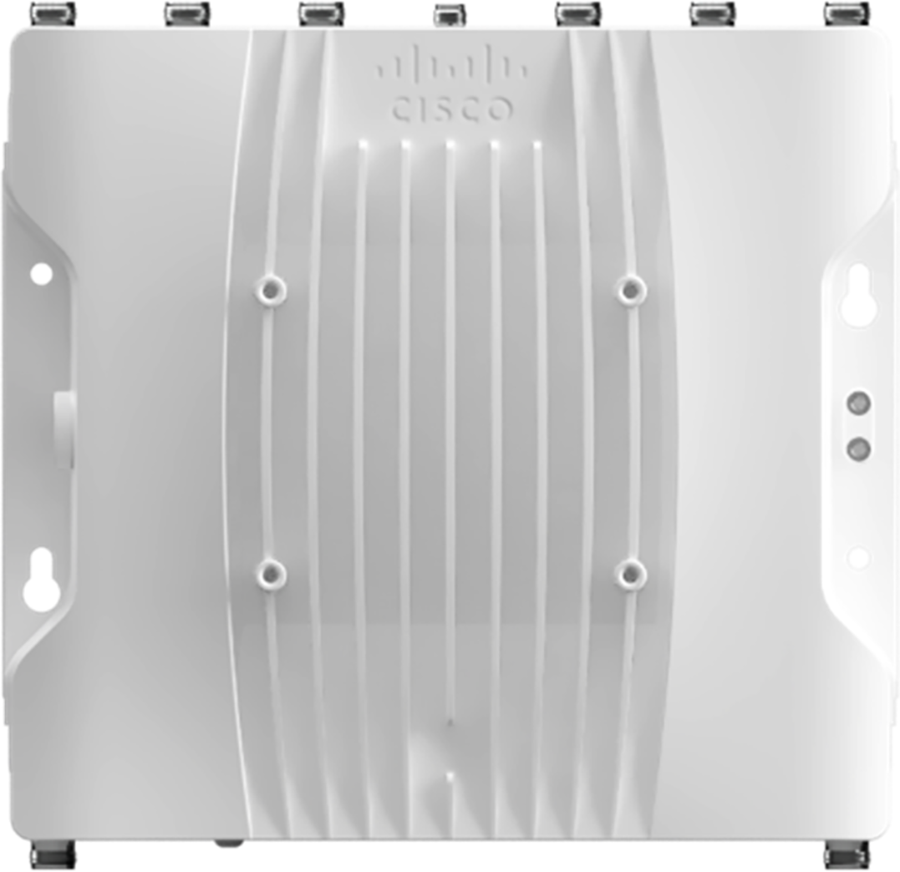
Catalyst IW9167E Heavy Duty Access Point
Cisco Catalyst IW9167I Heavy Duty Access Point
The Catalyst IW9167I is designed to make wireless deployments simple in outdoor and industrial environments. It is built with a cast-aluminum case that can handle water, dust, and extreme temperatures. It comes with a built-in antenna that enables high-throughput connectivity for high-density Wi-Fi clients.
The IW9167I supports Wi-Fi 6 technology and 6-GHz frequency band. That way organizations can deploy Wi-Fi 6E and get up to 1.2 GHz more spectrum to boost capacity and mitigate interference.
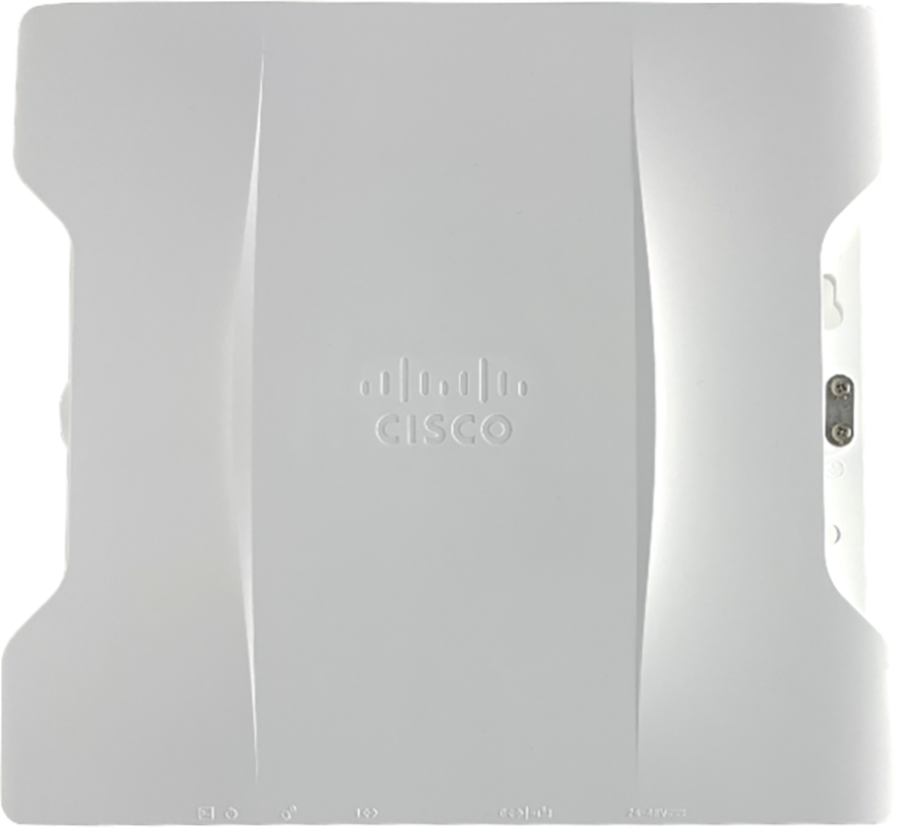
Catalyst IW9167I Heavy Duty Access Point
Catalyst IW9167E Heavy Duty Access Point for Hazardous Locations
The Catalyst IW9167E-HZ has all the capabilities, benefits, and features of the IW9167E Heavy Duty Access Point with the additional capability to deploy in Hazardous Locations (HAZLOC) around the world. Equipped with hardened ports and certified by UL, ATEX, and IECEx, the Catalyst IW9167E Heavy Duty Access Point for Hazardous Locations brings Wi-Fi 6, Wi-Fi 6E, and URWB into regulated explosive environments for the first time.
Note: IW9167E-HZ shares all specifications listed for IW9167E unless otherwise noted
Trustworthy systems built with Cisco Trust Anchor technologies provide a highly secure foundation for Cisco products. With the Cisco Catalyst IW9167 Series, these technologies enable assurance of hardware and software authenticity for supply chain trust and strong defense against man-in-the-middle attacks that compromise software and firmware. Trust Anchor capabilities include:
● Image signing
● Secure Boot
● Cisco Trust Anchor module
Table 1. Catalyst IW9167 Series features and benefits
| Feature |
Benefit |
|
| Wi-Fi 6 and Wi-Fi 6E |
The IEEE 802.11ax standard, also known as High-Efficiency Wireless or Wi-Fi 6, builds on 802.11ac. IW9167 series can support 4x4 MIMO and up to four spatial streams. Wi-Fi 6E is Wi-Fi 6 “extended” into the 6 GHz frequency band, allowing the use of additional channels. |
|
| Ultra-Reliable Wireless Backhaul (URWB) |
URWB provides ultra-reliable wireless connectivity for moving assets and extend network in scenarios where running fiber isn’t feasible or is too costly. It provides ultra-reliability, near-zero latency ( <10 ms), and zero packet loss with seamless handoffs. |
|
| Cisco Wireless with URWB§ |
Cisco Wireless with URWB enables the simultaneous use of URWB capabilities in Wi-Fi mode on a single hardware platform. This integration enhances your Wi-Fi infrastructure with an extra level of reliability to support your most demanding applications. |
|
| Flexible multi-technology support |
The IW9167E provides flexibility to choose the technology to use based on the use case. Ability to swap images in the field helps you select Wi-Fi, WGB, or standalone URWB operating modes without changing the hardware. |
|
| Tri-radio architecture |
IW9167E
● 2.4 GHz 4x4 radio: 20-MHz channels
● 5 GHz 4x4 radio: 20, 40, 80 MHz channels
● 5/6
* GHz 4x4 radio: 20, 40, 80, and 160 MHz channels
|
IW9167I
● 2.4 GHz 4x4 radio: 20-MHz channels
● 5 GHz 4x4 radio: 20, 40, 80 MHz channels
● 6
* GHz 4x4 radio: 20, 40, 80, and 160 MHz channels
|
| Multigigabit Ethernet |
Dual Multigigabit Ethernet supports speeds up to 5 Gbps. |
|
| Smart AP† ¥ |
Smart AP causes the access point to change its power consumption to reflect its current client load. An access point will typically operate on the radios provided to it regardless of how many clients are connected. With Smart AP, if the number of clients is small enough, the access point will automatically reduce the radio stream count, saving power. |
|
| Band steering¥ † |
Enhanced to help clients that are 6 GHz capable to leave the 5 GHz radio and connect to the 6 GHz one. Wi-Fi 6E clients are automatically directed to connect to the 6 GHz radio to take advantage of the benefits that the radio offers and free up the 2.4- and 5 GHz radios for legacy clients. IW9167 is Wi-Fi 6E ready, subject to approvals and regulations for the use of the 6 GHz spectrum by each country’s regulatory agencies. |
|
| Uplink/downlink OFDMA¥ |
Orthogonal Frequency-Division Multiple Access (OFDMA)-based scheduling splits the bandwidth into smaller frequency allocations called Resource Units (RUs), which can be assigned to individual clients in both the downlink and uplink directions to reduce overhead and latency. |
|
| Uplink/downlink MU-MIMO technology¥ |
Supporting four spatial streams, Multiuser Multiple Input, Multiple Output (MU-MIMO) enables access points to split spatial streams between client devices to maximize throughput. |
|
| BSS coloring¥ |
Spatial reuse (also known as Basic Service Set [BSS] coloring) allows the access points and their clients to differentiate between BSSs, thus permitting more simultaneous transmissions. |
|
| Target Wake Time¥ |
Target Wake Time (TWT) allows the client to stay asleep and to wake up only at prescheduled (target) times to exchange data with the access point. This offers significant energy savings for battery-operated devices, up to three to four times the savings achieved by 802.11n and 802.11ac. |
|
| Intelligent Capture¥ |
Intelligent Capture probes the network and provides Cisco DNA Center with deep analysis. The software can track more than 240 anomalies and instantaneously review all packets on demand, emulating the onsite network administrator. Intelligent Capture allows for more informed decisions on your wireless networks. |
|
| Bluetooth 5.1 |
The integrated Bluetooth Low Energy (BLE) 5.1 radio enables location-based use cases such as asset tracking, wayfinding, and analytics. |
|
| Scanning radio |
Dedicated radio for monitoring air space to perform advanced RF spectrum analysis and deliver features such as Cisco CleanAir®, Wireless Intrusion Prevention System (WIPS), etc. |
|
| Container support for applications |
Container support enables edge computing capabilities for IoT applications on the host access point. |
|
| Self-identifying antenna |
The access point can read information from antennas that support the Self-Identifying Antenna (SIA) feature and automatically populates antenna gain for plug-and-play antenna configuration. |
|
| GNSS |
A built-in GNSS (Global Navigation Satellite System) receiver provides coordinates to track the location of the access point. |
|
| M12 converters |
M12 converters give the flexibility to change Ethernet and power interfaces on the base unit into M12 interfaces while retaining all certifications. |
|
| Multipath operations†¢ |
Multipath Operations (MPO) can enhance reliability by sending duplicate copies of packets across multiple wireless paths. |
|
| WorkGroup Bridge (WGB) |
Provides wireless connectivity to a lightweight access point infrastructure on behalf of wired clients that are connected via Ethernet behind the WGB access point. |
|
Get reliable wireless connectivity for your mission-critical applications
As you automate your processes and operations to increase safety and productivity, you also need to improve your situational awareness to control your systems. Moving assets involved in mission-critical applications, such as Automated Guided Vehicles (AGVs), Autonomous Mobile Robots (AMRs), and teleremote devices, require reliable wireless connectivity. And sometimes you need to extend your network where running fiber isn’t feasible or is too costly.
The Catalyst IW9167 Series gives you flexibility and reliability so you can extend reliable wireless connectivity to more places and applications, with features such as:
● One hardware device, three different technologies: Protect your investment and evolve your wireless networks without the added cost of purchasing a new device. Simply update the software to run Wi-Fi 6, URWB, or WGB.
● MultiPath Operations (MPO):1 Patented technology that duplicates your high-priority traffic and works alongside hardware failures to increase availability, lower latency, and lower the effects of interference and hardware failures.
● WorkGroup Bridge (WGB): In workgroup bridge mode, the device associates to another access point as a client and provides a network connection for the equipment connected to its Ethernet port.
● Heavy-duty design: IP67-rated, hardened to withstand shock, vibration, and extreme temperatures. Supports industrial protocols and industrial certifications (e.g., the EN 50155 rail standard on the Catalyst IW9167E).
● Class I, Division 2, ATEX, and IECEx rated2: extend cutting edge wireless connectivity to explosive environments worldwide with the Catalyst IW9167E-HZ.
Table 2. Wi-Fi licensing
| Item |
Description |
| IW-DNA-E |
Industrial Wireless Cisco DNA Essentials |
| IW-DNA-A |
Industrial Wireless Cisco DNA Advantage |
Table 3. URWB Standalone licensing
| Item |
Description |
| IW9167-URWB-NW-E |
IW9167 URWB Standalone Network Essentials |
| IW9167-URWB-NW-A |
IW9167 URWB Standalone Network Advantage |
| IW9167-URWB-NW-P |
IW9167 URWB Standalone Network Premier |
| IOTOD-IW-E |
IW Service Essentials for URWB Standalone |
| IOTOD-IW-A |
IW Service Advantage for URWB Standalone |
Table 4. IW9167 Series product specifications
| Item |
Specification |
|||||||||||||||||||||||||
| Hardware |
Cisco Catalyst IW9167E Heavy Duty Access Point
● IW9167EH-x: Catalyst IW9167E for x domains
● IW9167EH-ROW: Catalyst IW9167E for ‘Rest of the World’
Cisco Catalyst IW9167I Heavy Duty Access Point
● IW9167IH-x: Catalyst IW9167I for x domains
● IW9167IH-ROW: Catalyst IW9167I for ‘Rest of the World’
Catalyst IW9167E Heavy Duty Access Point for Hazardous Locations
● IW9167EH-x-HZ: Catalyst IW9167E-HZ for x domains
● IW9167EH-ROW-HZ: Catalyst IW9167E-HZ for ‘Rest of the World’
Regulatory domains: (x = A, B, E, F, Q, or Z) ROW is for ‘rest of the world’ that is not covered as part of above-mentioned specific domain list. Customers are responsible for verifying approval for use in their individual countries. To verify approval and to identify the regulatory domain that corresponds to a particular country, visit https://cae-cnc-prd.cisco.com/pdtcnc/#/. Not all regulatory domains have been approved. As they are approved, the part numbers will be available on the Global Price List and/or regional price lists. See the ordering information section for actual orderable part numbers. |
|||||||||||||||||||||||||
| Software |
IW9167E-AP
● Cisco IOS
® XE Software Release 17.9.4 or later
IW9167E-URWB
● Cisco Unified Industrial Wireless Software 17.11.1 or later
IW9167E-WGB
● Cisco Unified Industrial Wireless Software 17.11.1 or later
IW9167I-AP
● Cisco IOS XE Software Release 17.12.1 or later
|
|||||||||||||||||||||||||
| Supported wireless LAN controllers |
● Cisco Catalyst 9800 Series Wireless Controllers (physical or virtual)
|
|||||||||||||||||||||||||
| 802.11n version 2.0 (and related) capabilities |
● 4x4 MIMO with four spatial streams in one 2.4 GHz radio and two 5 GHz radios
● Maximal Ratio Combining (MRC)
● 802.11n and 802.11a/g
● 20- and 40-MHz channels
● PHY data rates up to 1.5 Gbps (with 40 MHz on both 5 GHz radios and 20 MHz on the 2.4 GHz radio)
● Packet aggregation: Aggregate MAC Protocol Data Unit (A-MPDU) (transmit and receive), Aggregate MAC Service Data Unit (A-MSDU) (transmit and receive)
● 802.11 Dynamic Frequency Selection (DFS)
● Cyclic Shift Diversity (CSD) support
|
|||||||||||||||||||||||||
| 802.11ac |
● 4x4 downlink MU-MIMO with four spatial streams on both 5 GHz radios
● Maximal Ratio Combining (MRC)
● 802.11ac beamforming
● 20, 40, and 80 MHz channels
● PHY data rates up to 3.4 Gbps (dual 4x4:4SS 80 MHz)
● Packet aggregation: A-MPDU (transmit and receive), A-MSDU (transmit and receive)
● 802.11 DFS
● CSD support
● Wi-Fi Protected Access (WPA) 3 support
|
|||||||||||||||||||||||||
|
● 4x4 uplink/downlink MU-MIMO with four spatial streams in 2.4, 5, and 6 GHz
*
● Uplink/downlink OFDMA
● Target Wake Time (TWT)
● BSS coloring
● Maximal Ratio Combining (MRC)
● 802.11ax beamforming
● 20, 40, 80, and 160 MHz channels (IW9167E 5/6 GHz radio, IW9167I 6 GHz radio)
● 20, 40, 80 channels (5 GHz radio)
● 20 MHz channels (2.4 GHz radio)
● PHY data rates up to 7.8 Gbps (4x4 160 MHz on 6 GHz, 4x4 80 MHz on 5 GHz, and 4x4 20 MHz on 2.4 GHz)
● Packet aggregation: A-MPDU (transmit and receive), A-MSDU (transmit and receive)
● 802.11 DFS
● CSD support
● WPA3 support
|
||||||||||||||||||||||||||
| Antennas |
IW9167E and IW9167E-HZ
● 8x N-type antenna ports
● 1x TNC GNSS antenna port
● Cisco offers the industry's broadest selection of
antennas, delivering optimal coverage for a variety of deployment scenarios.
● Supports Self-Identifiable Antennas (SIA)
|
IW9167I
● 2.4 GHz: Peak gain 3.95 dBi, internal antennas, cross-polarized, omnidirectional
● 5 GHz: Peak gain 4.78 dBi, internal antennas, cross-polarized, omnidirectional
● 6 GHz: Peak gain 5.81 dBi, internal antennas, cross-polarized, omnidirectional
● BLE: Peak gain 3.05 dBi, internal antenna, vertical polarization, omnidirectional
● GNSS: Average gain -2 dBi, linearly polarized, omnidirectional antenna
|
||||||||||||||||||||||||
| Interfaces |
● 1x 100M/1000M/2.5G/5G Multigigabit Ethernet (RJ-45)/M12 X-code autosensing PoE+ in (802.3at/bt), UPOE in
● 1x SFP (copper) 100M/1000M/10G Multigigabit Ethernet /M12 X-code OR 1x SFP (fiber) 1G/10G
● Management console port (RJ-45)
● Multicolor system LED
● DC power input (micro-fit/M12 A-code)
● Reset button
Note: PG 13.5 glands or M12 converters shall be used with Ethernet and power interfaces to meet IP67 rating. Note: Catalyst IW9167E-HZ has permanent M25 ports. M12 converters are not compatible. See Installation Guide for gland requirements. |
|||||||||||||||||||||||||
| Dimensions |
IW9167E and IW9167E-HZ
● 11.5 x 10.5 x 2.8 in (29.2 x 26.7 x 7.1 cm)
Note: IW9167E-HZ has permanent M25 ports extending. 35” on bottom of Access Points but does not exceed overall dimensions listed |
IW9167I
● 11.5 x 10.5 x 3.0 in (29.2 x 26.7 x 7.6 cm)
|
||||||||||||||||||||||||
| Weight |
IW9167E
● 9.2 lb. (4.2 kg)
IW9167E-HZ
● 9.4 lb. (4.3 kg)
|
IW9167I
● 8 lb. (3.6 kg)
|
||||||||||||||||||||||||
| Input power requirements |
● 802.3at (PoE+), 802.3bt (UPOE+), Cisco Universal PoE (Cisco UPOE
®)
● DC power source: 24 to 48 VDC (maximum voltage range: 18 to 60 VDC)
● Cisco power AC-DC power adapter, IW-PWRADPT-MFIT4P=
● Cisco power injector, IW-PWRINJ-60RGDMG=
|
|||||||||||||||||||||||||
| Power draw |
Power input type |
2.4 GHz radio |
5 GHz radio |
5/6 GHz radio |
RJ45 |
SFP/SFP+ |
Power |
|||||||||||||||||||
| 24-48 VDC |
4x4 |
4x4 |
4x4 |
5Gbps |
Yes |
48W |
||||||||||||||||||||
| 802.3bt (UPOE) |
4x4 |
4x4 |
4x4 |
5Gbps |
Yes |
48W |
||||||||||||||||||||
| 802.3at (PoE+) |
2x2 |
2x2 |
2x2 |
1Gbps |
Yes/1G |
25W |
||||||||||||||||||||
| Note: Power required at the Power Source Equipment (PSE) will depend on the cable length and other environmental issues. |
||||||||||||||||||||||||||
| Surge |
IW9167E
● DC power input
◦ EN50121-4, ± 2 kV (line-earth) and ± 1 kV (line-line) ◦ AREMA, ± 1 kV (line-earth) and ± 1 kV (line-line) ◦ CISPR35, ± 0.5 kV (line-earth)
● Surge protection to ± 2 kV on Ethernet ports
●
Surge protection to ± 1 kV on SFP copper port with shielded cable
|
IW9167I
● DC power input
◦ CISPR35, ± 0.5 kV (line-earth)
● Surge protection to ± 2 kV on Ethernet ports
●
Surge protection to ± 1 kV on SFP copper port with shielded cable
|
||||||||||||||||||||||||
| Environmental |
IW9167E
● Nonoperating (storage) temperature: -40° to +185°F (-40° to +85°C)
● Nonoperating (storage) altitude test: +25˚C (77˚F), 17,000 ft.
● Operating temperature: -40° to +158°F (-40° to +70°C) with solar load and still air.
● Extended operating temperature (DC powered): -58° to +167°F (-50° to +75°C) without solar loading, still air, and cold start limited to-40°C
● Operating type test: +85°C for 16 hours
● Operating humidity: 0% to 100% (condensing)
● Operating altitude: 15,000 ft. (4,500 m)
● Wind resistance: Up to 160 mph (257 km/h) sustained winds
|
IW9167I
● Nonoperating (storage) temperature: -40° to +185°F (-40° to +85°C)
● Nonoperating (storage) altitude test: +25˚C (77˚F), 17,000 ft.
● Operating temperature: -40° to +131°F (-40° to +55°C) with solar load and still air
● Extended operating temperature (DC powered): -58° to +149°F (-50° to +65°C) without solar loading, still air, and cold start limited to -40°C
● Operating type test: +85°C for 16 hours
● Operating humidity: 0% to 100% (condensing)
● Operating altitude: 15,000 ft. (4,500 m)
● Wind resistance: Up to 160 mph (257 km/h) sustained winds
|
||||||||||||||||||||||||
| Environmental ratings |
● EN/IEC 60529 (IP66 and IP67)
|
|||||||||||||||||||||||||
| System memory |
● 2048 MB DRAM
● 1024 MB flash
|
|||||||||||||||||||||||||
| Data rates supported |
2.4 GHz radio: 802.11b: 1, 2, 5.5, 11 Mbps 802.11g: 6, 9, 12, 18, 24, 36, 48, 54 Mbps 802.11n: HT20 MCS0 – 31 802.11ax: HE20 MCS0 – 11, 1 to 4 spatial streams 5 GHz radio: 802.11a: 6, 9, 12, 18, 24, 36, 48, 54 Mbps 802.11n: HT20 and HT40, MCS0 to 31 802.11ac:
● VHT20 MCS0 to 8, 1 to 4 spatial streams
● VHT40 and VHT80 MCS0 to 9, 1 to 4 spatial streams
802.11ax:
● HE20, HT40, and HE80 MCS0 to 11, 1 to 4 spatial streams
IW9167E 5/6 GHz radio: 802.11a (5 GHz band only): 6, 9, 12, 18, 24, 36, 48, 54 Mbps 802.11n (5 GHz band only): HT20 and HT40, MCS0 to 31 802.11ac (5 GHz band only):
● VHT20 MCS0 to 8, 1 to 4 spatial streams
● VHT80, VHT160 MCS0 to 9, 1 to 4 spatial streams
802.11ax: HE20, HT40, HE80, and HE160 MCS0 to 11, 1 to 4 spatial streams IW9167I 6 GHz radio: 802.11ax: HE20, HE40, HE80, and HE160 MCS0 to 11,1 to 4 spatial streams |
|||||||||||||||||||||||||
| Frequency band and 20-MHz operating channels |
A (A regulatory domain):
● 2.412 to 2.462 GHz; 11 channels
● 5.260 to 5.320 GHz; 4 channels
● 5.500 to 5.700 GHz; 8 channels (excludes 5.600 to 5.640 GHz)
● 5.745 to 5.825 GHz; 5 channels
● 5.955 to 6.855 GHz; 46 channels
B (B regulatory domain):
● 2.412 to 2.462 GHz; 11 channels
● 4.920 to 4.980 GHz, 13 channels (license required)
● 5.180 to 5.320 GHz; 8 channels
● 5.500 to 5.720 GHz; 12 channels
● 5.745 to 5.825 GHz; 5 channels
● 5.955 to 6.415 GHz; 24 channels
● 6.535 to 6.855 GHz; 17 channels
E (E regulatory domain, outdoor):
● 2.412 to 2.472 GHz; 13 channels
● 5.500 to 5.700 GHz; 11 channels
● 5.855 to 5.935 GHz, 9 channels (10 MHz bandwidth only)
E (E regulatory domain, indoor):
● 2.412 to 2.472 GHz; 13 channels
● 5.180 to 5.320 GHz; 8 channels
● 5.500 to 5.700 GHz; 11 channels
● 5.955 to 6.415 GHz; 24 channels
● 5.955 to 6.415 GHz; 24 channels (IW9167I only)
F (F regulatory domain):
● 2.412 to 2.472 GHz; 13 channels
● 5.745 to 5.805 GHz; 4 channels
Q (Q regulatory domain):
● 2.412 to 2.472 GHz; 13 channels
● 4.920 to 4.980 GHz, 4 channels (license required)
● 5.500 to 5.720 GHz; 12 channels
Z (Z regulatory domain):
● 2.412 to 2.462 GHz; 11 channels
● 5.500 to 5.700 GHz; 8 channels (excludes 5.600 to 5.640 GHz)
● 5.745 to 5.825 GHz; 5 channels
Note: This varies by regulatory domain. Customers are responsible for verifying approval for use in their individual countries. To verify approval and to determine availability of the regulatory domain that corresponds to a particular country, visit https://cae-cnc-prd.cisco.com/pdtcnc/#/. |
|||||||||||||||||||||||||
| Maximum number of nonoverlapping channels |
2.4 GHz
● 802.11b/g:
◦ 20 MHz: 3
● 802.11n/ax:
◦ 20 MHz: 3
● 40 MHz: 1 (hardware capable)
|
5 GHz
● 802.11a:
◦ 20 MHz: 25
● 802.11n:
◦ 20 MHz: 25 ◦ 40 MHz: 12
● 802.11ac/ax:
◦ 20 MHz: 25 ◦ 40 MHz: 12 ◦ 80 MHz: 6 |
6 GHz*
● 802.11ax:
◦ 20 MHz: 59 ◦ 40 MHz: 29 ◦ 80 MHz: 14 ◦ 160 MHz: 7 |
|||||||||||||||||||||||
| Note: This varies by regulatory domain. Refer to the product documentation for specific details for each regulatory domain. |
||||||||||||||||||||||||||
| Available conducted transmit power settings (max/min), all antennas active |
2.4 GHz
● 24 dBm (250 mW)
● -4 dBm (0.4 mW)
|
5 GHz
● 30 dBm (1 W)
● -4 dBm (0.4 mW)
|
IW9167E 5/6 GHz
● 23 dBm (200 mW)
● -4 dBm (0.4 mW)
IW9167I 6 GHz
● 18 dBm (63 mW)
● -4 dBm (0.4 mW)
|
|||||||||||||||||||||||
| Conducted transmit power and receive sensitivity |
|
2.4 GHz radio |
5 GHz radio |
5/6 GHz radio (E) 6 GHz radio (I) |
||||||||||||||||||||||
| Data Rate / Spatial streams |
Total Tx power (dBm) |
Rx sensitivity (dBm) |
Total Tx power (dBm) |
Rx sensitivity (dBm) |
Total Tx power (dBm) |
Rx sensitivity (dBm) |
||||||||||||||||||||
|
|
|
E |
I |
E |
I |
E |
I |
E |
I |
E |
I |
E |
I |
|||||||||||||
| 802.11/11b |
||||||||||||||||||||||||||
| 1 Mbps |
1 |
27 |
30 |
-99 |
-100 |
- |
- |
- |
- |
- |
- |
- |
- |
|||||||||||||
| 11 Mbps |
1 |
27 |
30 |
-90 |
-91 |
- |
- |
- |
- |
- |
- |
- |
- |
|||||||||||||
| 802.11a/g |
||||||||||||||||||||||||||
| 6 Mbps |
1 |
27 |
30 |
-93 |
-94 |
30 |
30 |
-96 |
-94 |
23 |
- |
-96 |
- |
|||||||||||||
| 24 Mbps |
1 |
27 |
30 |
-84 |
-85 |
30 |
30 |
-87 |
-86 |
23 |
- |
-86 |
- |
|||||||||||||
| 54 Mbps |
1 |
27 |
27 |
-77 |
-78 |
27 |
27 |
-79 |
-78 |
21 |
- |
-79 |
- |
|||||||||||||
| 802.11n HT20 |
||||||||||||||||||||||||||
| MCS0 |
1 |
27 |
30 |
-94 |
-95 |
30 |
30 |
-96 |
-94 |
23 |
- |
-95 |
- |
|||||||||||||
| MCS7 |
1 |
26 |
26 |
-77 |
-77 |
25 |
25 |
-79 |
-77 |
20 |
- |
-79 |
- |
|||||||||||||
| MCS8 |
2 |
27 |
30 |
-92 |
-92 |
30 |
30 |
-93 |
-92 |
23 |
- |
-91 |
- |
|||||||||||||
| MCS15 |
2 |
26 |
26 |
-74 |
-74 |
25 |
25 |
-76 |
-74 |
20 |
- |
-76 |
- |
|||||||||||||
| MCS24 |
4 |
24 |
30 |
-89 |
-89 |
30 |
30 |
-90 |
-89 |
23 |
- |
-89 |
- |
|||||||||||||
| MCS31 |
4 |
24 |
26 |
-71 |
-71 |
25 |
25 |
-73 |
-71 |
20 |
- |
-73 |
- |
|||||||||||||
| 802.11n HT40 |
||||||||||||||||||||||||||
| MCS0 |
1 |
- |
- |
- |
- |
28 |
28 |
-94 |
-91 |
23 |
- |
-92 |
- |
|||||||||||||
| MCS7 |
1 |
- |
- |
- |
- |
25 |
25 |
-76 |
-74 |
20 |
- |
-76 |
- |
|||||||||||||
| MCS8 |
2 |
- |
- |
- |
- |
28 |
28 |
-91 |
-88 |
23 |
- |
-89 |
- |
|||||||||||||
| MCS15 |
2 |
- |
- |
- |
- |
25 |
25 |
-73 |
-71 |
20 |
- |
-73 |
- |
|||||||||||||
| MCS24 |
4 |
- |
- |
- |
- |
28 |
28 |
-88 |
-85 |
23 |
- |
-86 |
- |
|||||||||||||
| MCS31 |
4 |
- |
- |
- |
- |
25 |
25 |
-70 |
-68 |
20 |
- |
-70 |
- |
|||||||||||||
| 802.11ac VHT20 |
||||||||||||||||||||||||||
| MCS0 |
1 |
- |
- |
- |
- |
30 |
30 |
-96 |
-94 |
23 |
- |
-95 |
- |
|||||||||||||
| MCS8 |
1 |
- |
- |
- |
- |
24 |
24 |
-74 |
-72 |
19 |
- |
-75 |
- |
|||||||||||||
| MCS0 |
2 |
- |
- |
- |
- |
30 |
30 |
-93 |
-92 |
23 |
- |
-92 |
- |
|||||||||||||
| MCS8 |
2 |
- |
- |
- |
- |
24 |
24 |
-71 |
-69 |
19 |
- |
-72 |
- |
|||||||||||||
| MCS0 |
4 |
- |
- |
- |
- |
30 |
30 |
-90 |
-89 |
23 |
- |
-89 |
- |
|||||||||||||
| MCS8 |
4 |
- |
- |
- |
- |
24 |
24 |
-68 |
-66 |
19 |
- |
-69 |
- |
|||||||||||||
| 802.11ac VHT40 |
||||||||||||||||||||||||||
| MCS0 |
1 |
- |
- |
- |
- |
28 |
28 |
-94 |
-91 |
23 |
- |
-92 |
- |
|||||||||||||
| MCS9 |
1 |
- |
- |
- |
- |
24 |
24 |
-70 |
-69 |
19 |
- |
-71 |
- |
|||||||||||||
| MCS0 |
2 |
- |
- |
- |
- |
28 |
28 |
-91 |
-88 |
23 |
- |
-89 |
- |
|||||||||||||
| MCS9 |
2 |
- |
- |
- |
- |
24 |
24 |
-67 |
-66 |
19 |
- |
-68 |
- |
|||||||||||||
| MCS0 |
4 |
- |
- |
- |
- |
28 |
28 |
-88 |
-85 |
23 |
- |
-86 |
- |
|||||||||||||
| MCS9 |
4 |
- |
- |
- |
- |
24 |
24 |
-64 |
-63 |
19 |
- |
-65 |
- |
|||||||||||||
| 802.11ac VHT80 |
||||||||||||||||||||||||||
| MCS0 |
1 |
- |
- |
- |
- |
28 |
28 |
-91 |
-89 |
23 |
- |
-89 |
- |
|||||||||||||
| MCS9 |
1 |
- |
- |
- |
- |
23 |
24 |
-67 |
-66 |
19 |
- |
-67 |
- |
|||||||||||||
| MCS0 |
2 |
- |
- |
- |
- |
28 |
28 |
-88 |
-86 |
23 |
- |
-86 |
- |
|||||||||||||
| MCS9 |
2 |
- |
- |
- |
- |
23 |
24 |
-64 |
-63 |
19 |
- |
-64 |
- |
|||||||||||||
| MCS0 |
4 |
- |
- |
- |
- |
28 |
28 |
-85 |
-83 |
23 |
- |
-83 |
- |
|||||||||||||
| MCS9 |
4 |
- |
- |
- |
- |
23 |
24 |
-61 |
-60 |
19 |
- |
-61 |
- |
|||||||||||||
| 802.11ax HT20 |
||||||||||||||||||||||||||
| MCS0 |
1 |
27 |
30 |
-94 |
-95 |
30 |
30 |
-96 |
-94 |
23 |
16 |
-95 |
-96 |
|||||||||||||
| MCS11 |
1 |
23 |
23 |
-65 |
-66 |
23 |
23 |
-67 |
-65 |
16 |
16 |
-68 |
-69 |
|||||||||||||
| MCS0 |
2 |
27 |
30 |
-92 |
-92 |
30 |
30 |
-93 |
-92 |
23 |
16 |
-92 |
-93 |
|||||||||||||
| MCS11 |
2 |
23 |
23 |
-62 |
-63 |
23 |
23 |
-64 |
-62 |
16 |
16 |
-65 |
-66 |
|||||||||||||
| MCS0 |
4 |
24 |
30 |
-89 |
-89 |
30 |
30 |
-90 |
-89 |
23 |
16 |
-89 |
-90 |
|||||||||||||
| MCS11 |
4 |
23 |
23 |
-59 |
-60 |
23 |
23 |
-61 |
-59 |
16 |
16 |
-62 |
-63 |
|||||||||||||
| 802.11ax HE40 |
||||||||||||||||||||||||||
| MCS0 |
1 |
- |
- |
- |
- |
28 |
28 |
-94 |
-92 |
23 |
16 |
-92 |
-93 |
|||||||||||||
| MCS11 |
1 |
- |
- |
- |
- |
23 |
23 |
-64 |
-62 |
16 |
16 |
-64 |
-66 |
|||||||||||||
| MCS0 |
2 |
- |
- |
- |
- |
28 |
28 |
-91 |
-89 |
23 |
16 |
-89 |
-90 |
|||||||||||||
| MCS11 |
2 |
- |
- |
- |
- |
23 |
23 |
-61 |
-59 |
16 |
16 |
-61 |
-63 |
|||||||||||||
| MCS0 |
4 |
- |
- |
- |
- |
28 |
28 |
-88 |
-86 |
23 |
16 |
-84 |
-87 |
|||||||||||||
| MCS11 |
4 |
- |
- |
- |
- |
23 |
23 |
-58 |
-56 |
16 |
16 |
-58 |
-60 |
|||||||||||||
| 802.11ax HE80 |
||||||||||||||||||||||||||
| MCS0 |
1 |
- |
- |
- |
- |
28 |
28 |
-91 |
-89 |
23 |
18 |
-89 |
-90 |
|||||||||||||
| MCS11 |
1 |
- |
- |
- |
- |
22 |
23 |
-61 |
-60 |
16 |
18 |
-62 |
-63 |
|||||||||||||
| MCS0 |
2 |
- |
- |
- |
- |
28 |
28 |
-88 |
-86 |
23 |
18 |
-86 |
-87 |
|||||||||||||
| MCS11 |
2 |
- |
- |
- |
- |
22 |
23 |
-58 |
-57 |
16 |
18 |
-59 |
-60 |
|||||||||||||
| MCS0 |
4 |
- |
- |
- |
- |
28 |
28 |
-85 |
-83 |
23 |
18 |
-83 |
-84 |
|||||||||||||
| MCS11 |
4 |
- |
- |
- |
- |
22 |
23 |
-55 |
-54 |
16 |
18 |
-56 |
-57 |
|||||||||||||
| 802.11ax HE160 |
||||||||||||||||||||||||||
| MCS0 |
1 |
- |
- |
- |
- |
- |
- |
- |
- |
23 |
18 |
-86 |
-87 |
|||||||||||||
| MCS11 |
1 |
- |
- |
- |
- |
- |
- |
- |
- |
16 |
18 |
-58 |
-60 |
|||||||||||||
| MCS0 |
2 |
- |
- |
- |
- |
- |
- |
- |
- |
23 |
18 |
-83 |
-84 |
|||||||||||||
| MCS11 |
2 |
- |
- |
- |
- |
- |
- |
- |
- |
16 |
18 |
-55 |
-57 |
|||||||||||||
| MCS0 |
4 |
- |
- |
- |
- |
- |
- |
- |
- |
23 |
18 |
-80 |
-81 |
|||||||||||||
| MCS11 |
4 |
- |
- |
- |
- |
- |
- |
- |
- |
16 |
18 |
-52 |
-54 |
|||||||||||||
| Note: Values in this table assume all four antennas are used. |
||||||||||||||||||||||||||
| Compliance standards |
IW9167E Environmental EN 60529 IP67 UL50E Type 4X IEC 60068-2-1 (Cold) IEC 60068-2-2 (Dry Heat) IEC 60068-2-14 (Change of Temperature) IEC 60068-2-30 (Damp Heat) IEC 60068-2-6 (Vibration) IEC 60068-2-27 (Shock) IEC 60068-2-30 (Humidity) IEC 60068-2-32 (Freefall) IEC 60068-3-3 (Seismic) Electromagnetic compatibility FCC 47 CFR Part 15 Class A EN 55032 Class A VCCI Class A AS/NZ CISPR 32 Class A CISPR 32 Class A ICES 003 Class A CNS13438 Class A EN 300 386 KS C 9832:2019 EN 301 489-1 v2.1.1 EN 301 489-17 v2.1.1 EN 301 489 – 19 EN 55035 CISPR35 KS C 9835:2019 KS X 3124 KS X 3126 IEC/EN 61000-4-2 - Electrostatic Discharge IEC/EN 61000-4-3 - Radiated RF Immunity IEC/EN 61000-4-5 - Surge IEC/EN 61000-4-6 - Conducted RF Immunity IEC/EN 61000-4-8 - Power Frequency Magnetic Field IEC 61000-4-9 – Pulsed Magnetic Field IEC 61000-4-11 - AC Voltage Dips IEC 61000-4-18 - Damped Oscillatory Wave EN-61000-4-29 - DC Voltage Dips Safety IEC 62368-1 EN 62368-1 EN 62311 Flammability EN 45545-3 DIN 5510-2 Industrial EN 61000-6-2 - Industrial EN 61000-6-4 - Industrial EN 61000-6-1 - Light Industrial Rail AREMA C&S Manual Section 11.5.1 AAR S9401 Rail - Rolling stock cab, wayside outside EN 50155 Rail - Electronic Equipment on Rolling Stock Class TX (EMC, Environmental) EN 61373 Rail - Environmental EN 50121-4 Rail - Signaling and Telecommunications Apparatus EN 50121-3-2 Rail - Apparatus for Rolling Stock EN 61373 - Shock and Vibration Hazardous Locations (IW9167E-HZ only) Class I Division 2 (C1D2) UL/cUL C1D2 Zone 2/Zone 22 (ec+ic+tc) UL 121201 CSA C22.2 No 213 ANSI/UL 60079-0, -7, -11, -31 IECEx ATEX UKEx IEC/EN 60079-0 IEC/EN 60079-7 IEC/EN 60079-11 IEC/EN 60079-31 |
IW9167I Environmental EN 60529 IP67 UL50E Type 4X Electromagnetic compatibility FCC 47 CFR Part 15 Class A EN 55032 Class A VCCI Class A AS/NZ CISPR 32 Class A CISPR 32 Class A ICES 003 Class A CNS13438 Class A EN 300 386 KS C 9832:2019 EN 301 489-1 v2.1.1 EN 301 489-17 v2.1.1 EN 301 489 – 19 EN 55035 CISPR35 KS C 9835:2019 KS X 3124 KS X 3126 IEC/EN 61000-4-2 - Electrostatic Discharge IEC/EN 61000-4-3 - Radiated RF Immunity IEC/EN 61000-4-5 - Surge IEC/EN 61000-4-6 - Conducted RF Immunity IEC/EN 61000-4-8 - Power Frequency Magnetic Field IEC 61000-4-11 - AC Voltage Dips EN-61000-4-29 - DC Voltage Dips Safety IEC 62368-1 EN 62368-1 EN 62311 Industrial EN 61000-6-2 - Industrial EN 61000-6-4 - Industrial EN 61000-6-1 - Light Industrial |
||||||||||||||||||||||||
| Wireless communication standards |
Radio approvals
● FCC Part 15.247, 15.407
● FCC Part 90Y (IW9167E and IW9167E-HZ only)
● RSS 247
● EN 300 328 v2.2.2 (EU)
● EN 301 893 v2.1.1 (EU)
● EN 302 502 v2.1.1 (EU and UK) -( Applies to IW9167EH-E and IW9167EH-ROW)
● EN 302 571 v2.1.1 (EU) -applies to (IW9167EH-E)
● EN 303 413
● ARIB-STD 66 (Japan)
● ARIB-STD T71 (Japan)
● EMI and susceptibility (Class A)
● EN 303 687 - (IW9167IH LPI approval)
● AS/NZ 4268:2017 Amendment 1:2021 standard (IW9167IH LPI approval)
● Hongkong OFCA 6GHz approval (IW9167IH LPI approval)
IEEE Wi-Fi and security standards
● IEEE 802.11a/b/g/n/ac/ax, 802.11h, 802.11d, 802.11v, 802.11u, 802.11k, 802.11r
● IEEE 802.11i, Wi-Fi Protected Access 3 (WPA3), WPA2, WPA
● IEEE 802.1X
● Advanced Encryption Standards (AES), Temporal Key Integrity Protocol (TKIP)
Extensible Authentication Protocol (EAP) types
● EAP-Transport Layer Security (TLS)
● EAP-Tunneled TLS (TTLS) or Microsoft Challenge Handshake Authentication Protocol Version 2 (MSCHAPv2)
● Protected EAP (PEAP) v0 or EAP-MSCHAPv2
● EAP-Flexible Authentication via Secure Tunneling (FAST)
● PEAP v1 or EAP-Generic Token Card (GTC)
● EAP-Subscriber Identity Module (SIM)
Multimedia
● Wi-Fi Multimedia (WMM)
Other
● FCC Bulletin OET-65C
● RSS-102
|
|||||||||||||||||||||||||
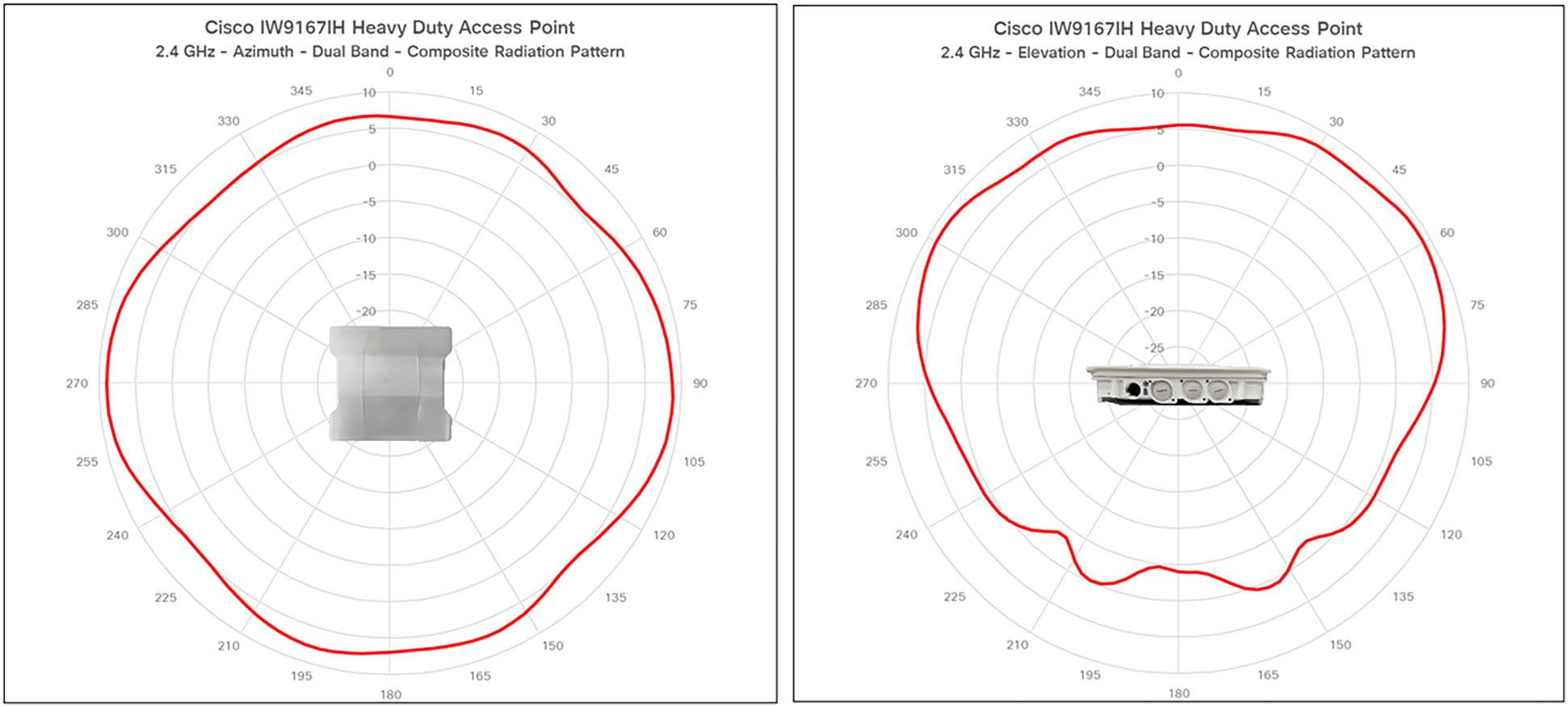
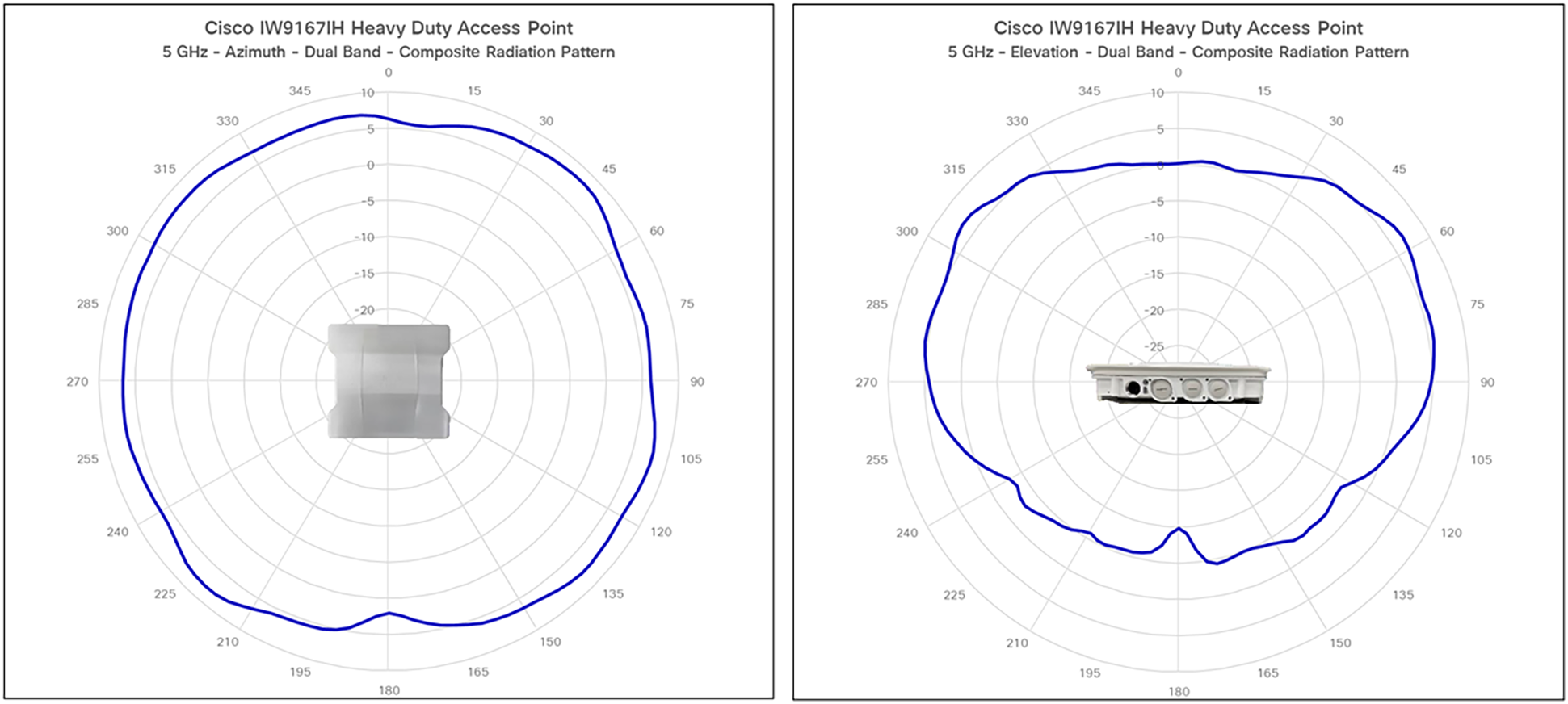
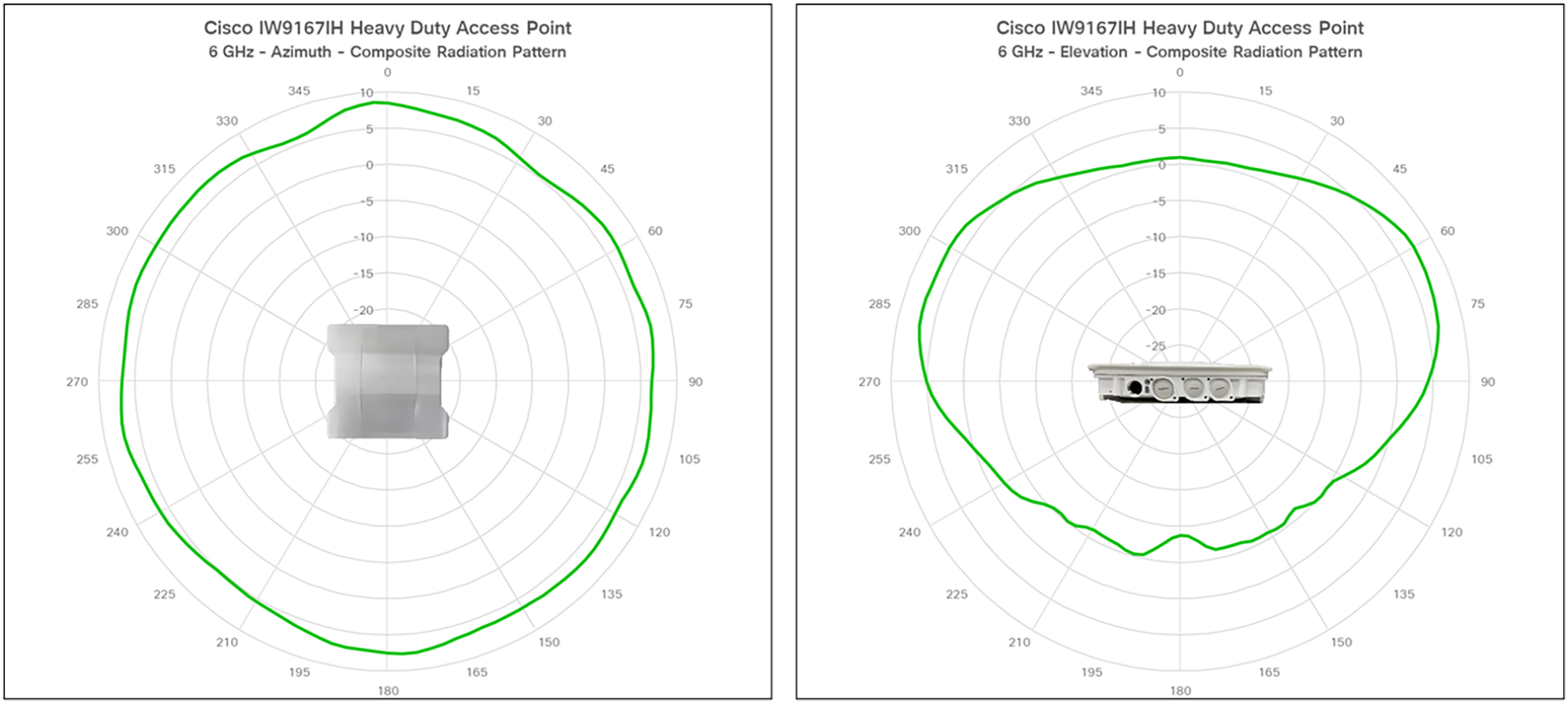
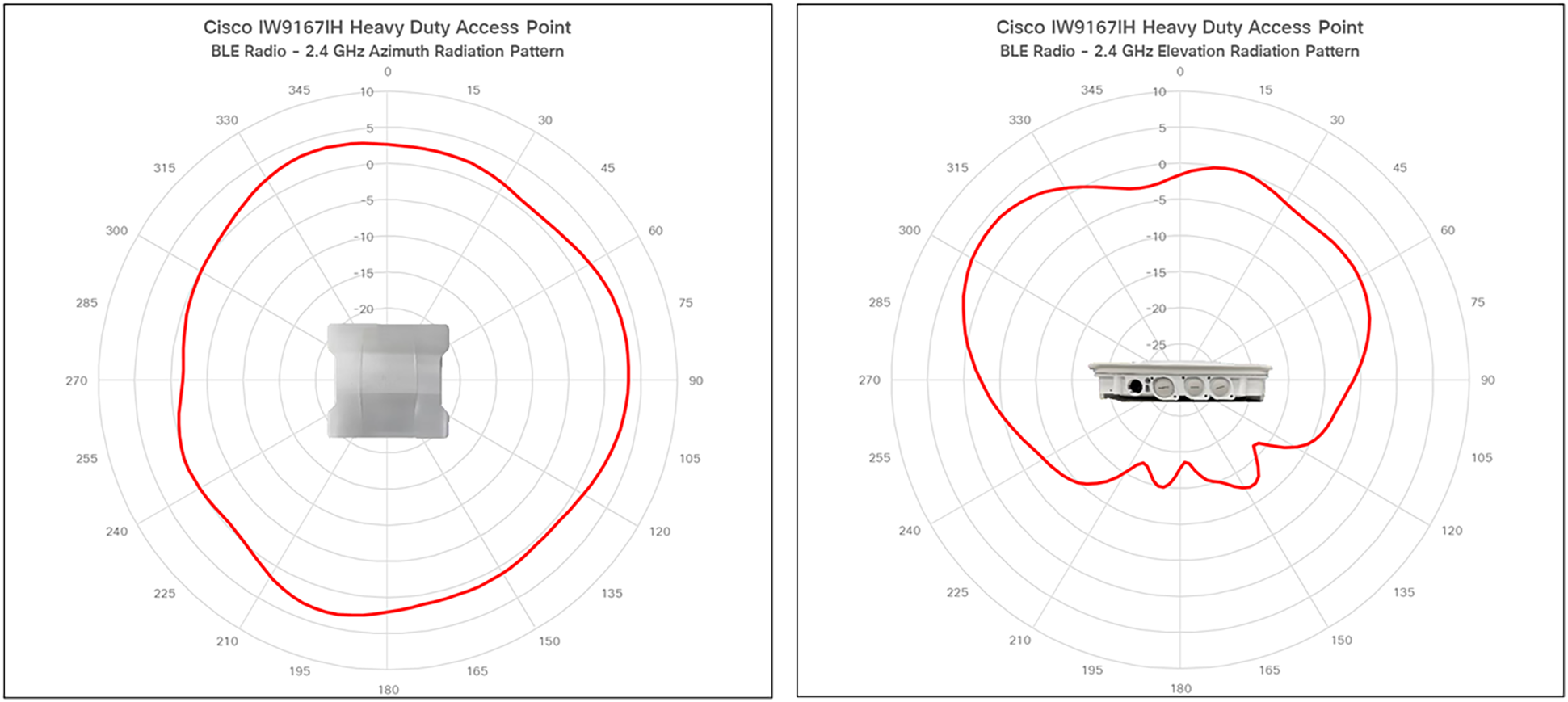
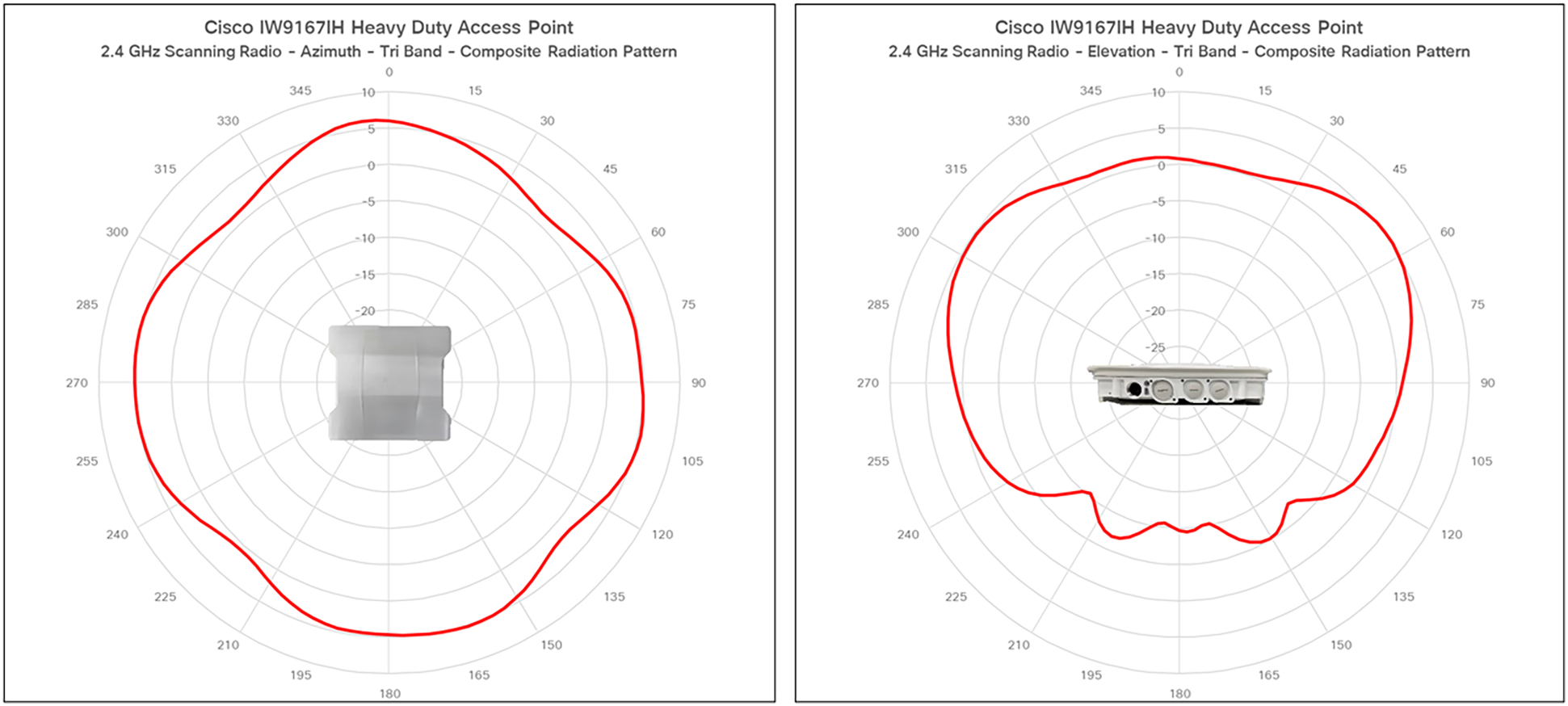
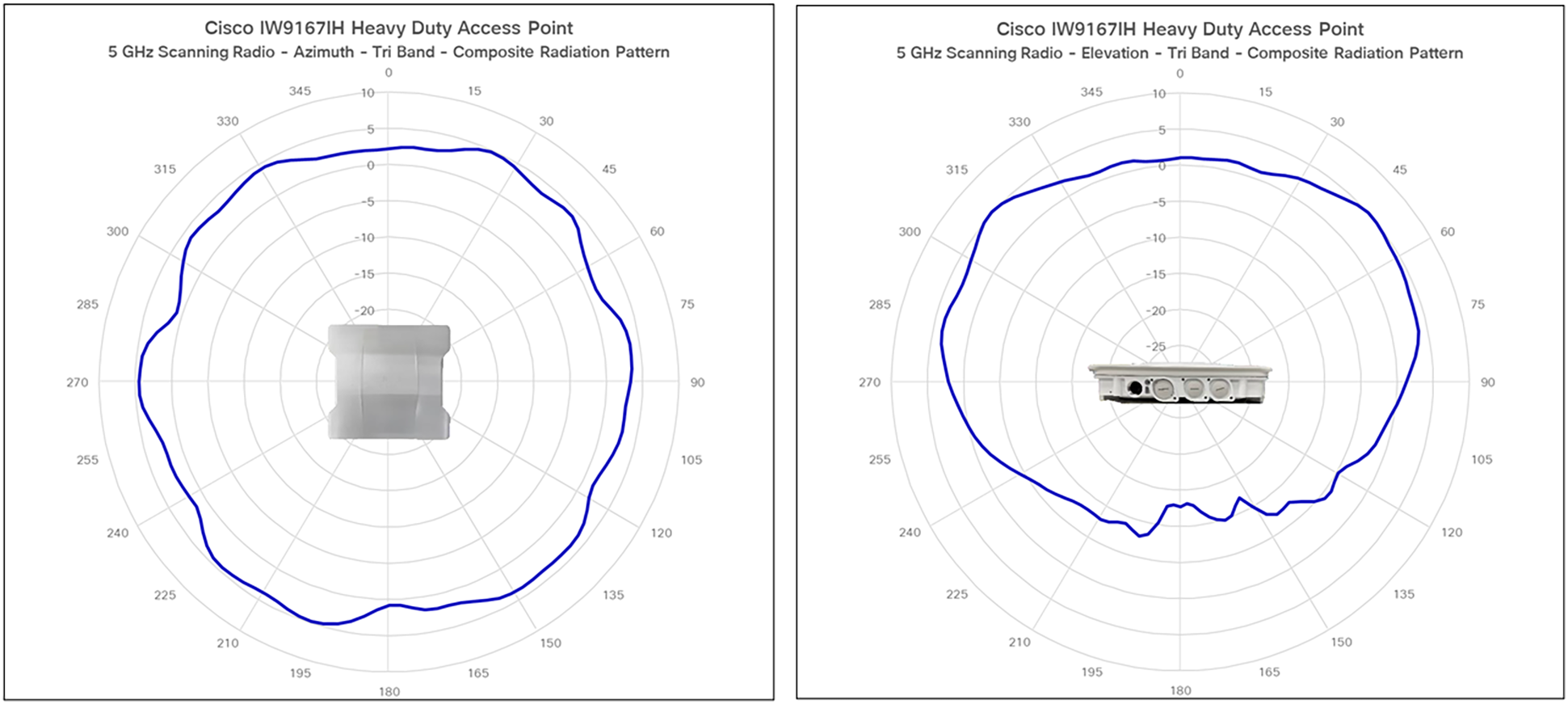
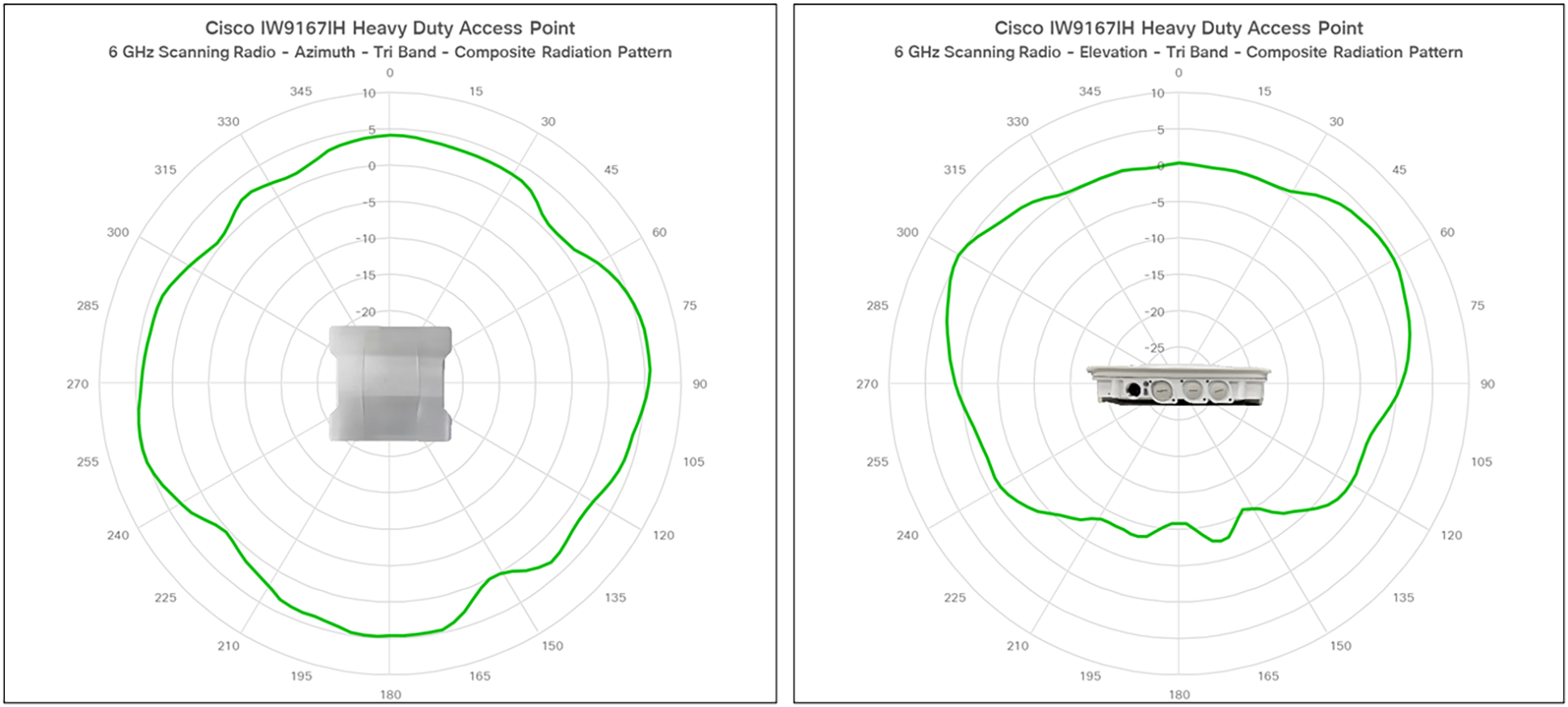
Table 5. Ordering information
| Part # |
Product description |
| IW9167EH-x-AP |
Industrial Wireless 9167E, 11ax 6E AP, 8 RF ports, x domain, Wi-Fi software |
| IW9167EH-x-URWB |
Industrial Wireless 9167E, 11ax 6E AP, 8 RF ports, x domain, URWB software |
| IW9167EH-x-WGB |
Industrial Wireless 9167E, 11ax 6E AP, 8 RF ports, x domain, WGB software |
| IW9167EH-x-HZ |
Industrial Wireless 9167EH-HZ, 11ax 6E AP, 8 RF ports, x domain, Hazardous Locations |
| IW9167IH-x-AP |
Industrial Wireless 9167I, 11ax 6E AP, internal antenna, x domain, Wi-Fi software |
The Catalyst IW9167 Series comes with a 1-year limited warranty. The warranty includes 10-day advance hardware replacement and ensures that software media are defect-free for 90 days. For more details, visit Product Warranties.
Information about Cisco’s Environmental, Social, and Governance (ESG) initiatives and performance is provided in Cisco’s CSR and sustainability reporting.
Table 6. Cisco environmental sustainability information
| Sustainability topic |
Reference |
|
| General |
Information on product-material-content laws and regulations |
|
| Information on electronic waste laws and regulations, including our products, batteries, and packaging |
||
| Information on product takeback and reuse program |
||
| Sustainability Inquiries |
Contact: csr_inquiries@cisco.com |
|
| Environmental operating temperature range |
||
| Power |
Power input |
|
| Power consumption |
||
| Material |
Product packaging weight and materials |
Contact: environment@cisco.com |
| Physical dimensions and weight |
||
Realize the full business value of your technology investments faster with intelligent, customized services from Cisco and our partners. Backed by deep networking expertise and a broad ecosystem of partners, Cisco Services enable you to deploy a sound, scalable mobility network that enables rich media collaboration while improving the operational efficiency gained from a converged wired and wireless network infrastructure. Together with our partners, we offer expert plan, build, and run services to accelerate your transition to advanced mobility services while continuously optimizing the performance, reliability, and security of that architecture after it is deployed. For more details, visit Services for Wireless.
Creating a Smart Account by using the Cisco Smart Software Manager (SSM) enables you to order devices and licensing packages and also manage your software licenses from a centralized website.
For more information on Smart Accounts, refer to https://www.cisco.com/go/smartaccounts.
Flexible payment solutions to help you achieve your objectives
Cisco Capital® makes it easier to get the right technology to achieve your objectives, enable business transformation and help you stay competitive. We can help you reduce the total cost of ownership, conserve capital, and accelerate growth. In more than 100 countries, our flexible payment solutions can help you acquire hardware, software, services, and complementary third-party equipment in easy, predictable payments. Learn more.
Get reliable wireless connectivity for any application, anywhere
Need to connect your mission-critical time-sensitive applications wirelessly with more bandwidth, higher reliability, and seamless handoffs? Take advantage of the 6 GHz band expansion and the flexibility to run one of two wireless technologies (Wi-Fi 6 or URWB) in a state-of-the-art hardware platform with the Cisco Catalyst IW9167 Series.
| New or Revised Topic |
Described In |
Date |
| Product overview and specifications |
Updated details about IW9167I platform |
May 31, 2023 |
| Multiple Sections |
IW9167E-HZ variant information added |
January 10, 2024 |